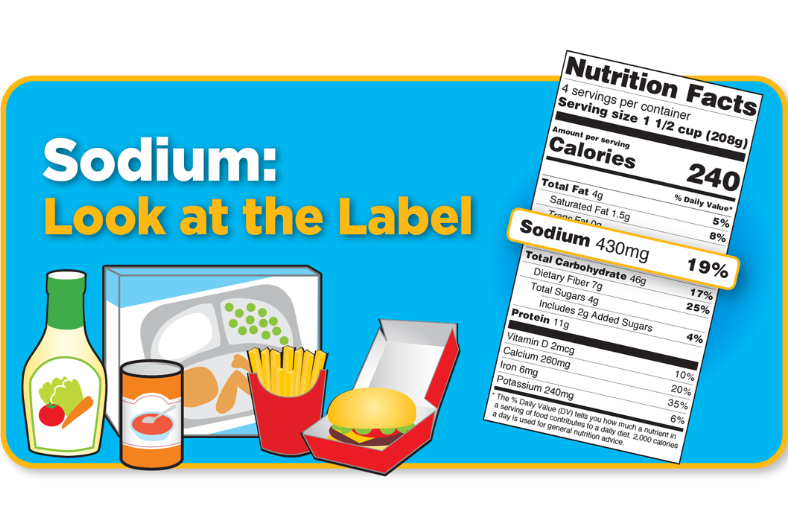You may have heard that the majority of Americans consume an excessive amount of salt. Salt contains sodium, and excessive sodium intake can raise blood pressure, which, if untreated, can have serious health effects.
The use of a salt shaker is not the primary factor in consuming too much sodium, contrary to popular belief. Packaged and fast-food foods account for more than 75% of daily sodium intake.
- The Nutrition Facts Label on the package of food and beverages is a useful tool for determining the amount of sodium in a food and making healthy dietary choices.
- Restaurants are not required to include a full nutrition label on their menu items unless they make nutrient claims like “Low Sodium” or “Low Fat.”
So, unless you ask, you might not know how much sodium is in a food.
Examine the Label
Even though foods that don’t “taste” salty may appear to have high sodium levels, sodium is not hidden on the Nutrition Facts Label!
- A food’s Percent Daily Value (%DV) of sodium is listed on the Nutrition Facts Label.
- The recommended daily allowance of sodium, which is less than 2400 milligrams (mg), is used as the basis for the %DV for sodium.
- The percentage of daily value is for a single serving, but many packages contain multiple servings!
Pay attention to the serving size and how many servings you actually consume. If you eat two servings, you get twice as much sodium (or twice the daily value), so pay attention to that.
The DV% indicates whether a food makes a small or large contribution to your daily diet.
- A daily value of 5 percent (120 mg) of sodium is considered low
- A daily value of 20 percent (480 mg) of sodium is considered high.
You can also quickly find foods that might have less sodium by looking at the front of the package.
For instance, look for foods that claim things like:
- Very Low: 35 milligrams of sodium or less per serving
- Low: 140 milligrams of sodium or less per serving
- Reduced: At least 25% less sodium than the original product
- Light in Sodium or Lightly Salted: At least 50% less sodium than the regular product
- No-Salt-Added: No salt is added during processing, but this does not necessarily mean that the product is sodium-free.
Make sure by checking the Nutrition Facts Label!
Connection Between Sodium and Health Sodium attracts water, and a diet high in sodium brings water into the bloodstream. This makes the blood bigger and can make your blood pressure go up over time. Hypertension, or high blood pressure, makes the heart work harder and can damage organs and blood vessels, increasing your risk of heart disease, kidney disease, and stroke.
Additionally, since blood pressure typically rises with age, limiting sodium intake becomes increasingly important with each passing year. The good news is that reducing sodium intake can frequently help bring blood pressure back into the normal range, thereby lowering your risk of developing these serious medical conditions.
Know Your Numbers
The human body requires a small amount of sodium to keep the body’s fluids in balance, maintain the smooth operation of muscles and nerves, and support the proper functioning of certain organs. However, nearly 90% of Americans consume an excessive amount of it without even realizing it.
On average, Americans consume 3,300 mg of sodium each day. Limit sodium intake to less than 2,300 milligrams (mg) per day, or about one teaspoon, according to the Dietary Guidelines for Americans.
If you belong to any of the following populations, which have been demonstrated to be more susceptible to sodium’s effects on raising blood pressure, you should further reduce your intake to 1500 mg per day.
- African-Americans
- People 51 and older
- People with high blood pressure, diabetes, or chronic kidney disease
These specific populations account for approximately half of the U.S. population and the majority of adults. Talk to your doctor about whether you are at risk for high blood pressure and use the Nutrition Facts Label as a tool to determine how much sodium you are consuming.
Final thoughts
Reaching your sodium goal will be made easier by learning about the sodium content of foods and new cooking methods. Additionally, if you follow these suggestions for lowering your sodium intake, you will gradually lose your “taste” for salt over time, increasing the likelihood that one day you won’t even miss it!
And if you seek further assistance.
We are prepared to help.
Reach out to us today.
Suave Concierge believes that the only way to get the desired results is to create the best possible connection between the patient and the doctor.

